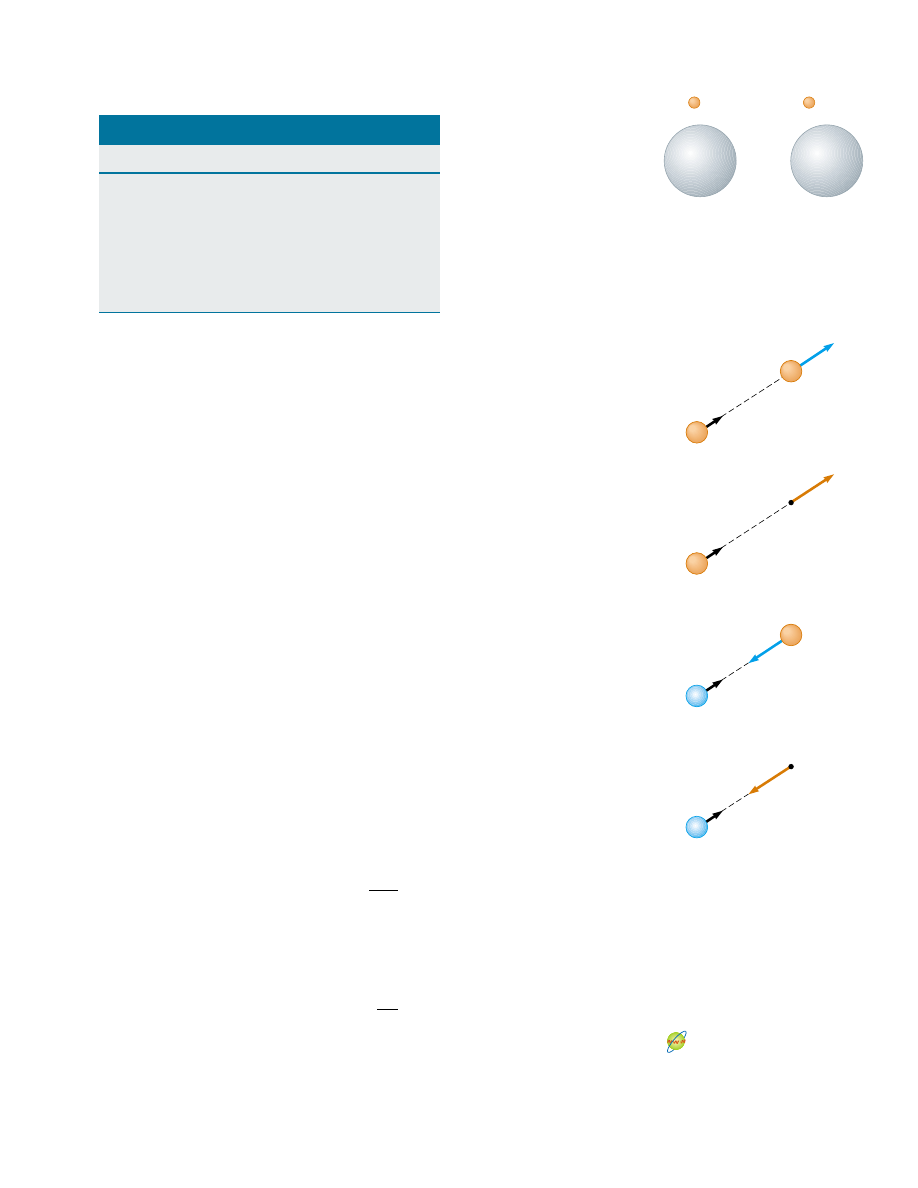Physics For Scientists And Engineers 6E - part 180

S E C T I O N 2 3 . 4 • The Electric Field
717
direction as the field. If q is negative, the force and the field are in opposite directions.
Notice the similarity between Equation 23.8 and the corresponding equation for a par-
ticle with mass placed in a gravitational field,
F
g
!
m
g (Eq. 5.6).
The vector
E has the SI units of newtons per coulomb (N/C). The direction of E,
as shown in Figure 23.11, is the direction of the force a positive test charge experiences
when placed in the field. We say that
an electric field exists at a point if a test
charge at that point experiences an electric force. Once the magnitude and direc-
tion of the electric field are known at some point, the electric force exerted on any
charged particle placed at that point can be calculated from Equation 23.8. The
electric field magnitudes for various field sources are given in Table 23.2.
When using Equation 23.7, we must assume that the test charge q
0
is small enough
that it does not disturb the charge distribution responsible for the electric field. If a
vanishingly small test charge q
0
is placed near a uniformly charged metallic sphere, as
in Figure 23.12a, the charge on the metallic sphere, which produces the electric field,
remains uniformly distributed. If the test charge is great enough (q
0
,
--
q
0
), as in
Figure 23.12b, the charge on the metallic sphere is redistributed and the ratio of the
force to the test charge is different: (F
e
,
/q
0
, .
F
e
/q
0
). That is, because of this redistribu-
tion of charge on the metallic sphere, the electric field it sets up is different from the
field it sets up in the presence of the much smaller test charge q
0
.
To determine the direction of an electric field, consider a point charge q as a
source charge. This charge creates an electric field at all points in space surround-
ing it. A test charge q
0
is placed at point P, a distance r from the source charge, as in
Figure 23.13a. We imagine using the test charge to determine the direction of the
electric force and therefore that of the electric field. However, the electric field
does not depend on the existence of the test charge—it is established solely by the
source charge. According to Coulomb’s law, the force exerted by q on the test
charge is
where
rˆ is a unit vector directed from q toward q
0
. This force in Figure 23.13a is
directed away from the source charge q. Because the electric field at P, the position
of the test charge, is defined by
E ! F
e
/q
0
, we find that at P, the electric field created
by q is
(23.9)
If the source charge q is positive, Figure 23.13b shows the situation with the test charge
removed—the source charge sets up an electric field at point P, directed away from q.
If q is negative, as in Figure 23.13c, the force on the test charge is toward the source
charge, so the electric field at P is directed toward the source charge, as in Figure
23.13d.
E ! k
e
q
r
2
rˆ
F
e
!
k
e
0
r
2
rˆ
Source
E (N/C)
Fluorescent lighting tube
10
Atmosphere (fair weather)
100
Balloon rubbed on hair
1 000
Atmosphere (under thundercloud)
10 000
Photocopier
100 000
Spark in air
-
3 000 000
Near electron in hydrogen atom
5 & 10
11
Typical Electric Field Values
Table 23.2
(a)
(b)
q
0
+
q
′
0
>>q
0
+
–
–
–
–
–
–
–
–
–
–
–
–
– –
–
–
–
–
–
–
–
–
–
–
Figure 23.12 (a) For a small
enough test charge q
0
, the charge
distribution on the sphere is undis-
turbed. (b) When the test charge
q
0
,
is greater, the charge distribu-
tion on the sphere is disturbed as
the result of the proximity of
q
0
,
.
Active Figure 23.13 A test charge
q
0
at point P is a distance r from a
point charge q. (a) If q is positive,
then the force on the test charge is
directed away from q. (b) For the
positive source charge, the electric
field at P points radially outward
from q. (c) If q is negative, then the
force on the test charge is directed
toward q. (d) For the negative
source charge, the electric field at P
points radially inward toward q.
At the Active Figures link at
http://www.pse6.com, you can
move point P to any position in
two-dimensional space and
observe the electric field due
to q.
(b)
E
q
r
P
rˆ
+
(a)
F
q
q
0
r
P
rˆ
+
–
(c)
F
q
q
0
P
rˆ
–
(d)
E
q
P
rˆ
r